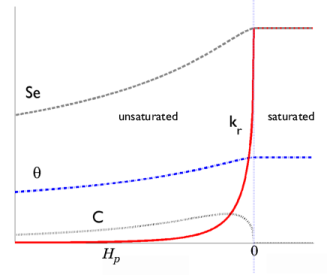where the pressure, p, is the dependent variable. In this equation,
Cm represents the specific moisture capacity,
Se denotes the effective saturation,
S is the storage coefficient,
κs gives the hydraulic permeability,
μ is the fluid dynamic viscosity,
kr denotes the relative permeability,
ρ is the fluid density,
g is acceleration of gravity,
D represents the elevation, and
Qm is the fluid source (positive) or sink (negative). Like Darcy’s law, COMSOL Multiphysics solves Richards’ equation for a dependent variable of pressure but provides features for specifying the values of the hydraulic head or pressure head on the boundaries of a model, either directly or as part of the Pervious Layer boundary condition. Also use the hydraulic head and the pressure head during results evaluation.
where u is the flux vector. The porous medium consists of pore space, fluids, and solids, but only the liquids move. The equation above describes the flux as distributed across a representative surface. To characterize the fluid velocity in the pores, COMSOL Multiphysics also divides
u by the volume liquid fraction,
θs. This interstitial, pore or average linear velocity is
ua = u/θs.
